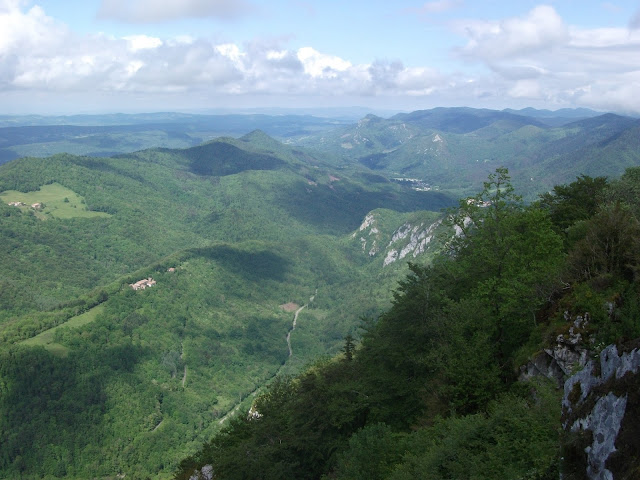 |
| In the village of Monségur |
Monségur, Languedoc, France in June 2016
You could call him the Magus of Monségur. He always carries a staff with him and wears a wide-brimmed felt hat. He has a solidity of presence, a compact energy and deep brown eyes which when they look at you give you the sense of looking into expanding ripples on water surface just after a stone has been thrown in.
We follow him into his living-room which is lined on all sides with books – on history, anthropology, mythology, poetry, the esoteric and occult, shamanism, art, Rennes-le-Chateau, the Cathars, whole sections devoted to books by Lovecraft, Poe, William Blake, Otto Rahn, and many others. The log fire is burning, fills the room with the sweet smell of wood smoke. He goes into the kitchen area to make us coffee and we arrange ourselves on various deep armchairs and gaze around us at the pictures on the walls, some of them painted by his mother he tells us, an artist and anthropologist in South Africa, but who returned to live in Ireland. He shows us one of her paintings that isn't on the wall – a beautiful detailed depiction of 'Goblin Market'.
He has pledged himself he says to protect the pog – the mountain – with the ruins where the Cathar castle of Monségur once stood, on the top. As is the tendency of new religions, to replace the sacred sites of the former religion, the Goddess of Monségur was present before the time of the Cathars (1100-1200s), he says. And as well as the pog itself, the surrounding mountains are full of old legends and folk-tales.
In the kitchen, as we make coffees for six people (Nescafé Espresso – recommended) he tells me that the castle is still seen as a heretical place, rather than being included and sheltered under the protective umbrella of the Catholic church, as a sacred place. And did you know he says, and he looks at me as he talks, as he looks at everyone – not glancing which might suggest he was furtive or indifferent, not staring as if you were an object or a minion, but a look held long enough that makes you feel included, a fellow-traveller on the path. Did you know that every year the villagers in Monségur had to perform a ritual penance for having offered sanctuary to the heretical Cathars? They had to drag a cross to the site where the last Cathars were burned. Otherwise they would suffer a papal anathema. And that this practice lasted up until the 1920s?
I had not known.
Later, he takes us up a path where there's a good view of the surrounding mountainsides and deep valleys and points out what he says is called 'montagne de la Frau'. I wondered, he said, why it was called the mountain of the lady, until I realised that it came from an old Occitan word, which translates into French as 'frayeur', in other words, the mountain of fear. He didn't elaborate on why it was given this name, though hinted at various folk tales from which the name derives.
Over lunch, he drops it quietly into the conversation that once people have been living here for a while, they begin to have very interesting dreams. 'And they start to say things like – I could really do with some chain mail or – I need to find a sword' – and he smiles. 'It could be something in the morphic field.' (Rupert Sheldrake's work on morphic resonance includes his theory on how memory can be inherited).
Formerly living in South Africa where he was an anthropologist and film maker (he still is, you can see a clip from his latest film The Otherworld/L'autre Monde here) he has lived in Monségur for over ten years and gives guided tours of the area. He also talks of the current plans by the commune to make improvements to the area around the pog and its ruined castle. To create a visitor centre, to fence off the hillside and, possibly, to have the castle floodlit, which he says would be detrimental to wildlife. (Since then the Mairie has responded and made a clear statement that there are no plans to fence off any areas or restrict access or have it floodlit, to the relief of all those who were concerned.)
 |
| The castle of Monségur |
After another excellent lunch, climbing up the steep path to the pog of Monségur crowned by its castle ruins, we witness a turning point in the weather. The fine rain has stopped, the mist is clearing, leaving just a shelf of clouds high up in the sky, and filmy wreaths of mist around the mountain tops. The higher we climb, getting ever closer to these clouds, they begin to break up and sunlight pours through like flattened gold coins on the surrounding plains and mountains.
This marks the end of the days of rain and cloud, the end of the moody reign of damp and veiled vision, of separation from the sun. The clouds thin out and disappear, the late afternoon and evening shine with reflected light. Warmth and sunlight return to the south.






Comments
This was the second time I climbed up the pog, but the first time in daylight. The first time was at night, in moonlight, just enough to see by, a warm summer night. We had the place all to ourselves and it was completely magical.
Rubyxx
And thank you Ruby, yes I agree that there is something about these mountains that are the opposite of distant but do in fact offer protection.
And I hope your eye problem is better now.
M xx
A brilliant blog post M. Xxx
I'm way behind with these French posts, but hope to get more up soon. The adventure continues...
M xx